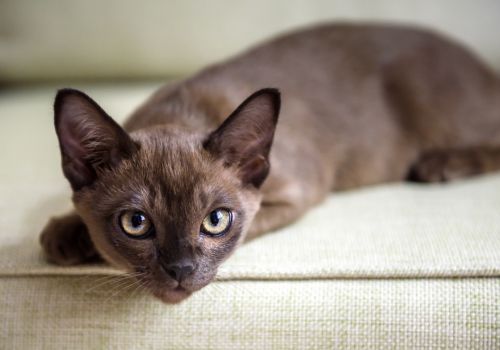If you're lucky enough to share your life with a Burmese cat, you already know you've got something special. Are they the type who meows back when you talk to them? Or maybe they still play with the zest of a kitten? Ah, the joys of having a Burmese!
The Best Bits of Burmese
Burmese cats are no wallflowers; they're the life of the party and maybe even the ones organizing it. Their curiosity knows no bounds, and they'll eagerly snoop around any new situation. Got a puzzle? They'll solve it. Heard a noise? They'll investigate it. Planning to take over the world? They'll want in on it—and honestly, they'd probably be great co-conspirators. They're fabulous with kids and other pets, usually handle their grooming like pros, and even welcome strangers with open paws.
The Quirks That Make Us Love Them More
Now, let's be real—no cat is without her quirks. Your Burmese may have an insatiable desire to be the center of your universe. Seriously, you might find her photobombing your Zoom calls or pawing at your book while you're trying to read. These cats are so social that being alone for too long can make them anxious. Yeah, they wear their hearts on their furry sleeves, and that's why we adore them!
The Fascinating History of the Burmese Breed
Ready for a quick history lesson that's actually interesting? Our beloved Burmese cats can trace their lineage back to a unique walnut-brown kitty named Wong Mau, who arrived in San Francisco all the way from Burma in the 1930s. Breeders paired her with Siamese males, and voila, the Burmese breed was born!
The Brick in the Velvet Glove
Ever picked up a Burmese and thought, "Wow, you're heavier than you look?" You're not imagining things! These cats are like little tanks packed with muscle, but you'd never know it thanks to their luxurious, close-lying coats. They're often described as "bricks wrapped in silk," and once you've cuddled one, you'll know exactly why.

So, there you have it—the Burmese cat in all its charming, quirky glory. If you've got one, you're likely already smitten. And if you're considering adding one to your family, prepare for a lot of love, laughter, and yes, a new boss of the household. But hey, with a cat this awesome, who wouldn't mind being bossed around a bit?
Genetic Predispositions for Burmese
Heart Matters: Endocardial Fibroelastosis
First on our list is a heart condition called Endocardial Fibroelastosis. Now, that's a mouthful, right? But here’s what it means: this disease makes the inner lining of the heart thick, affecting the valves and potentially leading to a heart murmur. In the worst-case scenario, this can cause congestive heart failure. While medications can prolong a kitten’s life, the prognosis isn’t great. Because it’s genetic, you should steer clear of breeding cats related to the affected kittens. So, yes, regular heart check-ups for your kitten are non-negotiable!
Heart Disease: The Sneaky Culprit
Speaking of heart matters, Cardiomyopathy is another disease that can sneak up on your fur baby. It affects the heart muscle and can either be genetic or secondary to other diseases. You might have heard terms like Hypertrophic Cardiomyopathy (HCM) or Dilated Cardiomyopathy (DCM). Good news! A proper diet can stave off DCM—so kudos to quality cat food manufacturers for adding essential amino acids like taurine. The tricky part? Cats are masters at hiding symptoms. The earliest signs often include quick breathing, tiredness, and a loss of appetite. Spotting this early is crucial, so those bi-annual vet visits are a must.
The Peril of Blood Clots: Arterial Thromboembolism
Here's one to watch out for: feline aortic thromboembolism, or FATE for short. It's a condition where blood clots block normal blood flow, most commonly affecting the hind legs. If this happens, it's an emergency, folks! Prompt medical care is essential, and cats who survive usually make a full recovery. So, if your Burmese has heart issues, ask your vet about medications to lower clot risks. Don't dilly-dally if your cat shows sudden signs of leg paralysis; rush to emergency care!
Sight for Sore Eyes: Glaucoma and More
Burmese cats can be susceptible to several eye issues, including the painful and urgent condition known as Glaucoma. It can rapidly lead to blindness if not treated pronto. The signs may include watery eyes, a bluish cornea, and redness. If you notice any of these symptoms, get your cat emergency care straight away. Regular eye screenings are your best defense.
The Eyelid Issue: Eyelid Agenesis
Another eye issue to be aware of is Eyelid Agenesis. Born with an improperly formed upper eyelid, affected cats suffer from constant irritation. Surgical eyelid reconstruction is usually the best treatment option for them. Post-surgery, most cats can look forward to a lifetime of normal vision.

Corneal Sequestration: A Patchy Situation
Corneal Sequestration is a condition where a hard, dark patch forms on the cornea, usually due to chronic inflammation. Early treatment may involve topical medications, but severe cases may need preventive surgery.
The Inside Scoop on Feline Diabetes Mellitus
Diabetes can strike any cat, regardless of breed, but some have a genetic predisposition that makes them more susceptible. However, lifestyle factors like a sedentary indoor life and poor diet can also trigger diabetes. That's right, our adorable window gazers might be at risk if we don't watch their weight and make sure they exercise. And let's not forget chronic pancreatitis, a painful condition that could lead to diabetes by damaging insulin-producing cells in the pancreas.
Unexpected weight loss despite a hearty appetite, excessive thirst, and frequent trips to the litter box. The good news is that many cats can manage their diabetes with a high-protein, low-carb diet and weight loss, sometimes avoiding the need for insulin shots. So keep an eye out, especially as your cat gets older, and remember—exercise and a balanced diet are your best preventive measures!
Navigating Through Renal Failure
Age is just a number, they say, but when it comes to kidney function, those numbers can start to matter. Renal failure is quite common in older cats, but young ones aren't entirely off the hook. Whether it's due to exposure to toxins or inherited kidney defects, renal failure is no joke. It's a severe, progressive disease that can greatly impact your feline's quality of life.

Early and regular exams are a game-changer. Special diets and medications can help manage symptoms and potentially extend your cat's life. No one wants to hear the words "renal failure," but catching it early can make all the difference.
FLUTD: What Your Cat's Litter Habits Are Really Saying
Ever find your cat doing its business outside the litter box and think, "How rude!"? Hold your horses—your cat might be sending out an SOS. Feline Lower Urinary Tract Diseases (FLUTD) is a collective term that describes various urinary issues, from bladder stones to urinary tract infections. If you spot signs like straining in the litter box or blood in the urine, don't delay; seek urgent care immediately, especially for male cats who can get dangerously blocked.
To catch these signs early, regular vet visits for urinalysis and imaging can be a lifesaver. Treatments range from special diets and medications to surgery in severe cases. So next time your cat skips the litter box, remember: it might not be a behavioral issue but a cry for help.
When Knees Go Wobbly: Patellar Luxation
If you've ever watched your cat leap and marveled at its agility, you have the stifle (or knee joint) to thank. But what happens when a part of this intricate structure, the patella, decides to take a detour? You get patellar luxation. While some cats show no early signs, as the condition advances, it can lead to lameness. Surgery might be required if symptoms worsen.
Here's a pro tip: Consider getting an x-ray around the time of spaying or neutering to check for any signs. Early detection can make treatment more effective, so keep those knees in check!
The Over-Sensitive Feline: Hyperesthesia Syndrome
Imagine feeling sensations so intensely that even a gentle touch sends your skin rippling. That's the world of a cat with hyperesthesia syndrome. These cats can experience discomfort from minor triggers and may resort to self-mutilation to cope. If your cat seems oversensitive, tests can rule out other similar conditions. Some medications can alleviate these extreme sensations, but ongoing monitoring is a must.
Stress and Your Cat: Psychogenic Alopecia
Does your cat seem to be losing hair for no reason? It might be dealing with psychogenic alopecia, a condition where cats over-groom due to stress or anxiety. Just like some people chew their nails when stressed, cats might lick themselves bald. However, rule out allergies and parasites first, as they can show similar symptoms.
The Itchy and Scratchy Show: Demodicosis
Ever heard of microscopic mites taking up residence in your cat's hair follicles? Welcome to the world of demodicosis. Some breeds, like Burmese, are more prone to this, but the immune system usually keeps these critters in check. However, if your cat starts to scratch excessively and develops red lesions, it's time to check for demodicosis. Skin scrape tests can confirm the diagnosis, followed by topical treatments or medicated baths to kill the mites. Sometimes antibiotics may be required for secondary infections.
If you have questions and you'd like to reach out to us, you can call us directly at (276) 265-8183, or you can email us at [email protected]. Don't forget to follow us on social media Facebook, Instagram.

